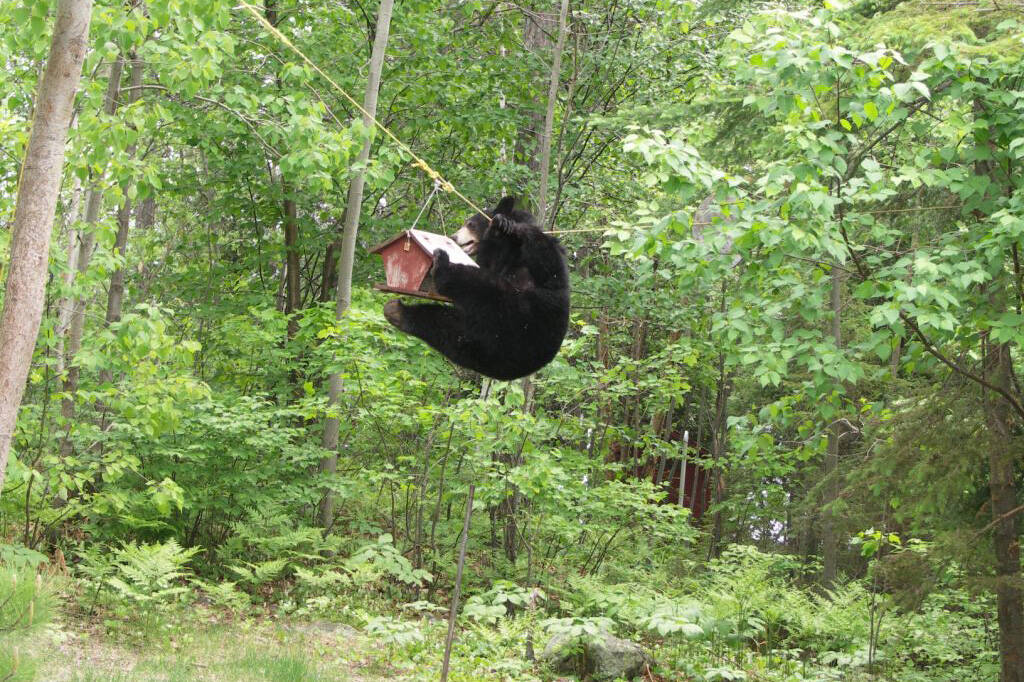With reports of bears getting into chicken coops, the Alaska Department of Fish and Game has put out its annual reminder to take measures to keep bears from being attracted to food, livestock and anything else that might cause dangerous interactions with humans and pets.
Spring also means cow moose will start calving, and people also should work to avoid interactions with mama moose and newborn calves.
According to a press release, on May 10, Homer Police got a report of a bear in a chicken coop on Kachemak Way that ran away when the caller fired a gunshot warning into the air. Then on May 11 another caller reported a bear tearing up his beehive on Bay Avenue. Officers responded and chased off the bear.
The homeowner contacted Alaska Department of Fish and Game wildlife biologist Jason Herreman, and Herreman said he advised the beekeeper to put electric fencing around the hives and coop. The bear also had been checking out a chicken coop. Herreman said the homeowner got the fence around the hive, and was discouraged by it, but the homeowner didn’t have time to get a fence around the chicken coop. The bear came back and took a chicken.
“Fearing the bear would return, the owner shot and killed the bear,” the police press release said.
“It was one of those unfortunate things, negligence on the person’s fault and the bear being a bear,” Herreman said.
The bear was a black bear, Herreman said.
“They’re pretty persistent animals once they learn about a food source,” Herreman said. “That’s the hardest thing to get them to understand: If you prevent them from getting a good source, you don’t have a problem.”
Along with bees and chicken coops, people should take these precautions:
• Take down bird feeders and put bird seed in a safe place away from bears. People sometimes leave containers of bird seed on decks or porches that bears then get into.
• Clean out compost bins or put them behind electric fences.
“This time of year they’re prepping their gardens,” Herreman said. “(Gardeners) may have their compost bins open and bears get attracted to that. … Fish waste in the compost is definitely going to bring them in.”
• Put livestock feed in bear resistant containers or in secure areas — but not in vehicles. Herreman said one woman put pig feed in her truck “she locked the truck doors and it (a bear) ripped the handles off the truck.”
• Put fish smokers in a secure area.
• Put garbage in a secure area or in bearproof cans.
“We’ve had them go through the sides of flimsy sheds before,” Herreman said.
• Don’t feed pets outside or leave dog or cat food outside.
• Put barbecue grills in a secure area or clean grills and grease traps.
• Don’t leave freezers out on decks.
“The best thing is to clean that grease trap after each use and store it in the garage,” Herreman said. “That cuts down the scent and gets it out of the way.”
Spring also means cow moose will start birthing calves.
“We want to remind folks to give those cows space. They do tend to get a little ornery,” he said. “We have more injuries from moose than from bears. Often it involves a cow with a calf.”
People should give calves space, too, Herreman said. People want to take pictures of them, but should do so at a distance and with telephoto lenses.
With newborn calves also come reports of orphaned calves. That may not be the case, Herreman said.
“A lot of time that’s simply a cow who has put the calf in a space and walked away a bit and will come back to it,” he said.
The late spring has meant more snow than usual at the higher elevations, and more moose down in town.
“This year we seem to have a high number of moose in town,” Herreman said. “… We’ll have a few more interactions with moose than we have some years.”
Another issue — and a potential bear attractant — has been winter moose kills, where moose drop dead from disease or starvation. There have been more calls this year than in previous years, and calls started earlier, Herreman said — as early as January. More people are finding dead moose melting out of deep snow and as they walk around their property, he said.
A dead moose is the owner’s responsibility. If a person has a lot of acreage and the dead moose isn’t near a home and a hazard, it can be left as is for bears, coyotes, wolves and ravens to clean up. Dead moose also can be buried or, if conditions permit, burned. If a person needs to remove a dead moose, Herreman asked them to call ADF&G and let them know so neighbors won’t think a moose has been poached. The Homer Transfer Station will take carcasses, and there is a form to fill out. ADF&G also can provide the contacts for businesses that remove dead moose. Call the Homer office at 907-235-8191.
Reach Michael Armstrong at marmstrong@homernews.com.


